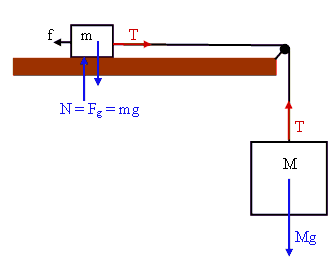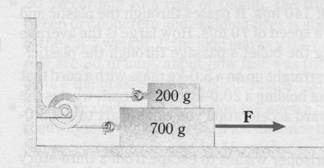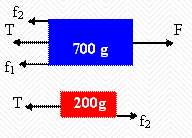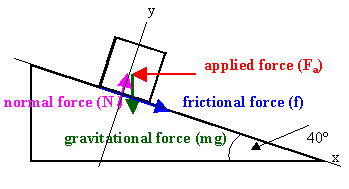Newton's 2nd law, friction
Problem:
A box of mass m slides across a horizontal table with
coefficient of friction μ. The box is
connected by a rope which passes over a frictionless pulley to a body of mass M
hanging along side the table. Find the acceleration of the system and the
tension in the rope.
Solution:
- Concepts:
Newton's second law
- Reasoning:
For each box we have F = ma. The magnitude of
a
is the same for each box.
- Details of the calculation:

Mg - T = Ma.
T - f = ma.
f = μmg.
a = (M - μm)g/(M +
m), T = Mg - Ma = Mmg(1 + μ)/(m
+ M).
Problem:
In the figure below the coefficient of friction is the same at the top and the
bottom of the 700-g block.
(a) Draw a free body diagrams for both the 200-g and the 700-g blocks,
considering all forces.
(b) If the acceleration is a = 70 cm/s2 when F = 1.3 N, how large is
the coefficient of friction?

Solution:
- Concepts:
Newton's second law
- Reasoning:
This is a simple Newtonian Mechanics problem.
- Details of the calculation:
(a) Forces acting in the horizontal direction:

(b) F - T - f1
- f2 = Ma, T - f2 = ma.
f1 = μ(M + m)g, f2 = μmg.
F - ma - f1 - 2f2 = Ma.
F - μ Mg - 3μ mg = (M + m)a.
μ = [F - (M + m)a]/[Mg + 3mg].
μ = [1.3 - 0.9*0.7]/[1.3*9.8] = 0.0526 .
Problem:
A trunk weighing 500 N is to be pushed up a rough incline by an applied
horizontal force F. The incline makes an angle of 40o with the
horizontal. If a force of 1000 N is sufficient to move the trunk at a constant
velocity of 0.200 m/s, what is the coefficient of kinetic friction between the
trunk and the incline?
Solution:
- Concepts:
Newton's 2nd law, the force of friction,
the normal force, the gravitational force
- Reasoning:
The trunk is moving in an inertial frame with constant velocity. It is not
accelerating, Newton's 2nd law requires that the net force is
zero. In addition to the applied force, the force of friction, the normal
force, and the gravitational force are acting on the trunk
The vector sum of all the forces acting on the trunk must be zero.
- Details of the calculation:

Choose the axes of your coordinate system as shown. The x- and y-components
of the net force must be zero.
x-component:
f + mg sin(40o) - Facos(40o) = 0. Solve
for f.
f = (1000 N) cos(40o) - (500 N) sin(40o) = (444.65 N).
y-component:
N - mg cos(40o) - Fasin(40o) = 0. Solve
for N.
N = mg cos(40o) + Fasin(40o) = (1025.81 N).
Use f = μN to find the coefficient μ.
μ = f/N = 0.43.
Problem:
A block is given a quick push along a horizontal table. The coefficient
of kinetic friction between the block and the table is μk. It
is known that during the time interval t (immediately after the push) the block
covers a distance d. Find the distance that may be covered by the block
during the subsequent time interval t'. Find all possible answers.
Solution:
- Concepts:
Newton's 2nd law, friction, kinematics
- Reasoning:
The force of kinetic friction is responsible for the
acceleration of the block.
- Details of the calculation:
Let the block's mass be m, its momentum
just after it received the impulse be p = mv0i.
dpx/dt = -μkmg until the block comes to rest.
Therefore px decreases at a steady rate until the block comes to
rest, ax = μkg.
The block comes to rest at time trest
= v0/(μkg).
The block can cover a maximum distance
dmax = v0trest - ½μkgtrest2
= ½v02/(μkg).
Case (a) t ≥ trest,
d = dmax, then the distance covered during the subsequent time
interval t' is zero.
Case (b) t + t' ≥ trest, then the
distance covered during the subsequent time interval t' is dmax -
d.
Case (c) t + t' < trest, then the distance covered during
the subsequent time interval t' is
d' = v0(t + t') -
½ μkg(t + t')2 - d = v0t' -
½ μkg t'2 - μkgtt'.
Problem:
You are going to entertain children by pulling a tablecloth out from under
the the cake at a birthday party. The birthday cake is resting on a
tablecloth at the center of a square table. Each side of the table has
length l = 1.84 m. The tablecloth is the same size as the table top.
You grab the edge of the tablecloth and pull sharply in a direction along one of
the sides. The tablecloth and cake are in contact for time t after you
start pulling. Then the sliding cake is stopped (you hope) by the friction
between the cake and table top. The coefficient of kinetic friction
between the cake and tablecloth is μk1 = 0.310 , and that between the
cake and table top is μk2 = 0.410. Calculate the maximum value
of t if the cake is not to end up on the floor. Neglect the size of the
cake compared to the size of the table.
Solution:
- Concepts:
Newton's 2nd laws, kinematics
- Reasoning:
Let the direction of motion of the tablecloth be
the positive x-direction.
Assume that the cake moves a distance d while
still on the tablecloth and a distance
Δx while sliding on the table
top.
Assume it falls off the table when its center reaches the edge of
the table, i.e. when d + Δx = l/2.
- Details of the calculation:
(i) The cake is still in
contact with the tablecloth and is moving in the direction of motion of the
tablecloth.
The only force acting on the cake in the horizontal
direction is friction.
f = ma = μk1mg, a = μk1g in
the positive x-direction..
d = ½μk1gt2 is distance
the cake slides during its contact with the tablecloth.
Its velocity when
it looses contact with the tablecloth is μk1gt, in the positive
x-direction.
(ii) The cake is now in contact with the table.
Again,
the only force acting on the cake in the horizontal direction is friction.
f = ma = -μk2mg, a = -μk2g. The direction of the
acceleration is now in the negative x-direction.
The cake will move a
distance Δx before it comes to rest.
vxf2
= vxi2 + 2aΔx. Δx =
vxi2/(2μk2g)
= (μk1gt)2/(2μk2g).
To solve for the maximum t we set d +
Δx = l/2.
½μk1gtmax2 + (μk1gtmax)2/(2μk2g)
= l/2.
tmax2 = l/[g(μk1 + μk12/μk2)]
= 0.345 s2.
tmax = 0.587 s.
Problem:
In a gravity-free environment a particle of mass m is constrained to
move on the inside of a circular track of radius R. The coefficient of kinetic
friction between the particle and the tack is μ. At t = 0 the particle is given
an impulse of magnitude p0.
(a) How long does it take the particle to move once around the
track?
(b) What
is its speed after one revolution?
Solution:
- Concepts:
Circular motion
- Reasoning:
For the particle of mass m to move with speed v on the inside of the
circular track, the track has to exert a force mv2/R towards the
center of the circle. This is a normal force.
The frictional force with magnitude f = μN = μ mv2/R will slow the
particle down.
- Details of the calculation:
(a) mdv/dt = -μmv2/R, dv/v2 = -(μ/R)dt.
Integrate: ∫v0v(t)dv'/v'2 = -(μ/R)t. 1/v0
- 1/v(t) = -(μ/R)t. v(t) = v0/(1 + (μv0/R)t).
The distance s(t) traveled in time t is s(t) = ∫0tv(t')dt'
= v0∫0tdt'/(1 + (μv0/R)t').
s(t) = (R/μ) ∫11 + (μv0/R)t dt'/t' = (R/μ)ln(1 +
(μv0/R)t).
For s(t) = 2πR we have 2πμ = ln(1 + (μv0/R)t), exp(2πμ) = 1
+ (μv0/R)t.
t = (exp(2πμ) - 1)R/(μv0) = (exp(2πμ) - 1)mR/(μp0).
(b) vafter one revolution = v0/(1 + (exp(2πμ) -
1)) = v0 exp(-2πμ) = (p0/m) exp(-2πμ).
Or
dv/dt = (dv/ds) ds/dt = ½dv2/ds = - μv2/R.
v2(s) = v02exp(-2μs/R), v(s) = v0exp(-μs/R),
vafter one revolution = v0 exp(-2πμ).
v(s) = ds/dt dt = ds/v(s) = ds exp(μs/R)/v0.
Integrate from 0 to 2πR to find t(2πR) = (exp(2πμ) - 1)R/(μv0).




